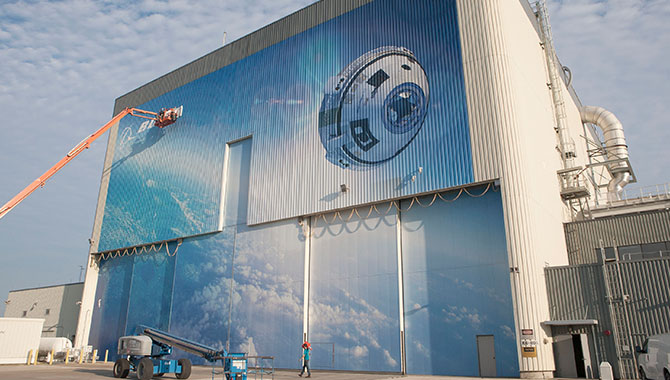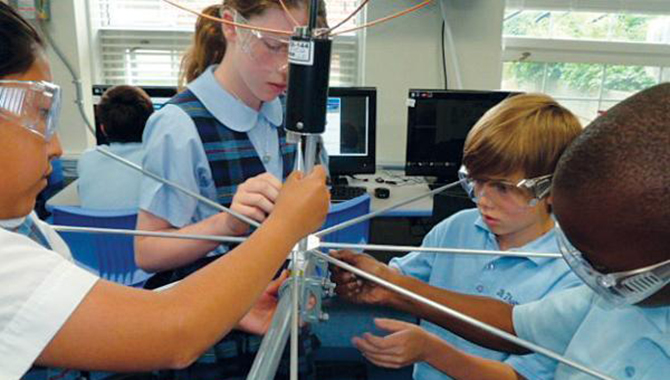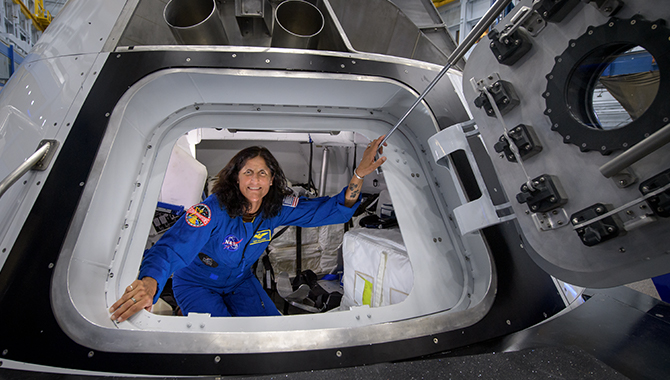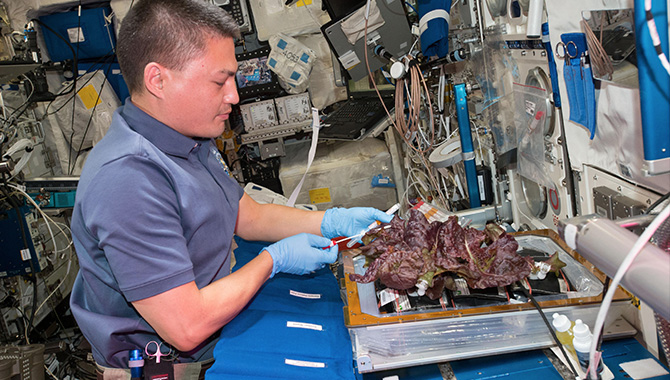
Boeing’s Commercial Crew and Cargo Processing Facility (C3PF) at Kennedy Space Center features a mural of the CST-100 Starliner, the company’s commercial crew transportation spacecraft. The C3PF is located on the site of the shuttle program’s Orbiter Processing Facility-3.
Photo Credit: NASA/Kim Schiflett
As NASA focuses on developing technologies to send humans to Mars, commercial companies continue to advance capabilities for use in low Earth orbit (LEO).
For years, NASA has worked with private industry to expand commercial aerospace opportunities and create a thriving economy in LEO. In 2008, with the first Cargo Resupply Contracts (CRS) for commercial transportation to and from the International Space Station (ISS), the agency ushered in an entirely new way of doing business in space. Orbital ATK and Space Exploration Technologies (SpaceX) developed the ability to make regular cargo deliveries to the ISS, enabling the agency to focus its attention and resources on other programs. A second CRS in 2016 extended ISS delivery capacity by adding Sierra Nevada Corporation (SNC) to the list of cargo-transport providers.
In September 2014, NASA expanded its partnership with private industry by announcing the selection of Boeing Space Exploration (Boeing) and SpaceX to develop commercial capabilities for crew transport in LEO. The Commercial Crew Program (CCP) is designed to return human spaceflight launches to U.S. soil while reducing launch costs and offering greater flexibility for delivering crew to the space station.
Both initiatives have inspired a new industry in LEO, spurring economic growth and fostering breakthroughs in science and technology. At a recent International Space Station Research and Development (ISSR&D) Conference in Washington, DC, representatives from five commercial space companies talked about ongoing efforts to spark a vibrant economy in space.
Frank DeMauro, Vice President and General Manager in the Advanced Programs Group at Orbital ATK, talked about the evolution of its Cygnus spacecraft from a cargo-delivery vehicle to a science platform and multi-use spacecraft. Expanding the functionality of the Cygnus will enable the company to meet the emerging research needs of both NASA and private industry.
“One of the things we’re looking at is offering the capability of having a very clean, very low-disturbance environment within Cygnus and to offer that environment to experimenters and payload providers, which we think will be valuable moving forward,” said DeMauro.
At SNC, where a version of their Dream Chaser spacecraft will begin delivering cargo to the ISS as soon as 2020, they are working on a variety of potential missions that do not involve the space station. One idea, said Steven Lindsey, Vice President Space Exploration Systems at SNC, is to offer services to nations that currently have no presence in space. The company is working with the United Nations on one such initiative: a free-flying science mission in which multiple countries could participate by providing payloads that would be carried by SNC spacecraft. Because the Dream Chaser can land in a variety of locations, it would also offer the ability to touch down in different nations, as needed.
“We’re in the business to commercialize low Earth orbit. We are focused on that. Any time we do anything with Dream Chaser, we’re always thinking about how that applies to the future, either beyond space station or in other commercial markets,” said Lindsey.
Focusing on making space more accessible for scientific research, NanoRacks has emerged as an on-station resource for cubesat deployment and other services. Over roughly five years, NanoRacks has brought over 550 payloads to the space station and deployed more than 180 satellites.
“We’re beginning to see a very interesting market for satellite deployment from space station. We have a program called Stash and Deploy, where you can bring your satellites to the station, leave them there for months at a time, and then deploy. I happen to believe that over the next five, six, seven years, we’re going to be very disruptive for the launch vehicle market and the desire to launch on demand,” said Jeffrey Manber, Chief Executive Officer (CEO) of the company.
Amid the rapid expansion of private industry in LEO, Kennedy Space Center (KSC) serves as a vital hub for the activity of many of the commercial aerospace organizations that construct rockets, build spacecraft, and provide launch services for agency as well as industry missions. Boeing, which is focused on expanding human spaceflight capabilities as it develops the CST-100 Starliner for NASA’s commercial crew initiative, is an important part of that growing community. The company is doing much of its work at KSC in former Orbiter Processing Facility-3, now known as the Commercial Crew and Cargo Processing Facility (C3PF).
“That area of the Space Coast has turned into a place where formerly just payloads were processed and launched into a place where engineering is now actively done and fabrication is performed. So it’s become a very vibrant institution for the central Florida area. And we’re proud to see that and be a part of it,” said Christopher Ferguson, Director of Crew and Mission Operations at Boeing.
Considering everything he sees going on in Florida and in the aerospace industry around the world, he said, “There will be a day where you don’t need to be a military test pilot, you don’t need to have a PhD in physics, you don’t need to be a part of a government organization. If we are successful in our endeavor of going back and forth safely to low Earth orbit and doing it repeatedly from the commercial perspective, that opens up the realm for just about anybody who has the desire and a couple bucks to go to low Earth orbit.”
In Europe, Airbus Defense & Space is a key contributor to the commercial expansion of LEO. Carlo Mirra, Director of Space Product Sales at the company, summarized the growing conviction that LEO is ripe for development. “[W]e all have a feeling we’re going through exciting times. Big, fast changes. Global changes. Not just driven by the technology, the innovation, the scientific discoveries, but also the overall economic situation, the geopolitical situation that of course is affecting space, is affecting low Earth orbit.”
He added, “I observe a bolder attitude in the private sector that is definitely much more willing to put capital at risk in order to develop space capabilities, infrastructure, and services.”
The actions of these and other private companies as well as space agencies around the world are opening up space to humanity in a way that is unprecedented. All involved believe that a vital LEO economy is within reach, and all are developing technologies and innovating solutions to facilitate its growth. Their immediate goal is to create a business case that establishes the commercial viability of space.
NASA supports these initiatives as critical components in expanding the U.S. and global economy as well as facilitating the agency’s journey to Mars.
“I think we need a vibrant low Earth orbit economy,” said NASA’s Acting Administrator, Robert Lightfoot, during his keynote address at the ISSR&D Conference. “I there’s a lot of ways to get to space, there’s a lot of ways to partner with people to make things happen.”
He added, “There really are no boundaries to this journey we’re on of exploration and discovery. Only our own imaginations.”
Read an APPEL News article about the benefits of the agency’s Commercial Crew Program.
Learn more about commercial cargo transport to the ISS in this APPEL News article.









